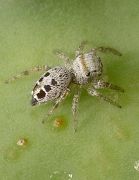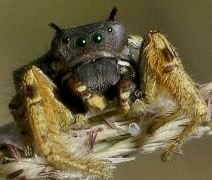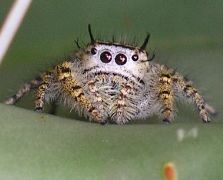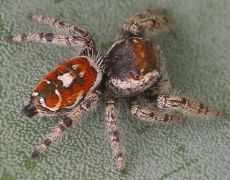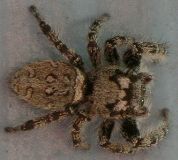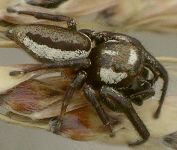
| Salticidae ~ Jumping Spiders |
|
After P. audax, the next most numerous species around here is Phidippus arizonensis. This is a highly variable species with big differences between males and females. Immature males are hard to tell from females, but the mature males are quite distinctive. Both genders have obvious tufts of hair sticking up over their eyes, often visible when they look straight at an observer (which is most of the time).
Mature male P. arizonensis have fairly consistent coloring: the gray abdomen has a black spot near the rear, the legs are gold colored, with the front ones being very hairy, and the cephalothorax is black with white side markings. There is almost a continuum from female to male coloring, and I'm not sure if ALL mature males look the same as I don't always get a good look at their pedipalps to be certain. Sometimes males can be distinguished by their smaller abdomen in contrast to the larger females, but because the abdomens expand and contract depending on how well fed they are, this is not a reliable way to tell the sexes apart.
The females and immature males come in an amazing array of colors, from tan to brown to red, sometimes with metallic in the center of the rear of the abdomen. The markings vary a lot too. The clues to look for include fully-formed parenthesis marks at the rear of the abdomen, a rather compact white bell shape in the middle, and a light band across between the eyes. Sometimes the markings can be very contrasting and complete and sometimes they are absent. This species is frequently found on prickly pear cactus. Our other Phidippus species are not all that common. Phidippus carolinensis shows up occasionally, and it looks very similar to P. arizonensis. Besides the markings on the abdomen, the black area at the back of the cephalothorax that comes to a point in the center is a good identification clue.
Another uncommon and yet similar looking species is Phidippus pruinosus. As is often the case, it is necessary to look at several different marks to determine the identity of any individual. The sort of V-shaped spot in the center of the abdomen and the indistinct light color between the eyes along with the light sides to the cephalothorax are good clues.
I've only seen females or immature males of Phidippus mystaceus, but they are rather variable. When the markings are clear, those around the top of the cephalothorax between the eyes are the best way to recognize this species. Other times the marks are obscured and not very helpful.
There are other genera besides Phidippus that contain relatively large jumping spiders, especially the females. In fact, it is easy to mistake female Bronze Jumpers (Eris militaris) for a Phidippus species. They vary a bit in color but the markings are usually pretty diagnostic. The males are quite different, with much simpler markings. Both genders often have metallic brown, but it must be seen in the right light to show clearly.
Another very large jumper is Platycryptus undatus. This gray and black species is rather flattened and very hairy. It is a common resident of our garage and most members of this species seem to prefer to live around human structures, especially concrete and stonework. Males and females have the same markings
There is a spider that looks much like a smaller and more delicate version of Platycryptus undatus and that is Menemerus bivittatus. I am not sure if this species occurs here in Austin, but it is quite common closer to the coast. The photo shown here was taken in Houston. |
![]()
